ด้วยตัวเลือกของ **เครื่องวัดการไหล** ที่มีมากมายในตลาด การเลือกเครื่องวัดที่เหมาะสมเป็นสิ่งสำคัญอย่างยิ่งเพื่อให้มั่นใจถึงความแม่นยำและความน่าเชื่อถือในการวัด การเลือกเครื่องวัดการไหลที่ไม่เหมาะสมอาจนำไปสู่ความผิดพลาดในการวัดหรือการสอบเทียบที่ไม่ถูกต้อง ส่งผลต่อความแม่นยำของข้อมูล
ดังนั้น การทำความเข้าใจความสัมพันธ์ระหว่าง **การไหล ความเร็ว และเส้นผ่านศูนย์กลางของท่อ** เป็นสิ่งจำเป็นก่อนที่จะเลือกเครื่องวัดการไหลที่เหมาะสม บทความนี้จะอธิบายประเด็นดังกล่าวอย่างละเอียด เพื่อช่วยให้คุณเลือกเครื่องวัดการไหลที่ตอบโจทย์ความต้องการของคุณได้ดีที่สุด
1. วิธีคำนวณอัตราการไหลจากขนาดท่อ
ความสัมพันธ์ระหว่างการไหล ความเร็ว และเส้นผ่านศูนย์กลางของท่อ สามารถคำนวณได้ด้วยสูตรต่อไปนี้ โดยต้องคำนึงถึงการแปลงหน่วยที่เกี่ยวข้องด้วย
ตัวอย่างการคำนวณ:
- สำหรับท่อที่มีเส้นผ่านศูนย์กลาง 2 นิ้ว และความเร็วการไหล 1 เมตรต่อวินาที เราสามารถคำนวณอัตราการไหลได้ดังนี้:
- เส้นผ่านศูนย์กลางภายใน (ID) ของท่อขนาด 2 นิ้วคือ 51 มม.
- ใช้สูตรพื้นที่หน้าตัดของท่อ: พื้นที่ = (ID² ÷ 4) × π
- เมื่อคำนวณแล้ว พื้นที่หน้าตัดจะเท่ากับ 0.002041785 ตารางเมตร
- จากนั้น คูณพื้นที่หน้าตัดของท่อด้วยความเร็วการไหล เพื่อหาค่าอัตราการไหล:
- อัตราการไหล = 0.002041785 × 1 = 0.002041785 ลูกบาศก์เมตรต่อวินาที
- แปลงค่าเป็นลิตรต่อนาที (LPM): 0.002041785 × 1000 × 60 = 122.5071 LPM
ดังนั้น อัตราการไหลของท่อขนาด 2 นิ้ว ที่ความเร็วการไหล 1 เมตรต่อวินาที จะเท่ากับ 122.5071 ลิตรต่อนาที (LPM)
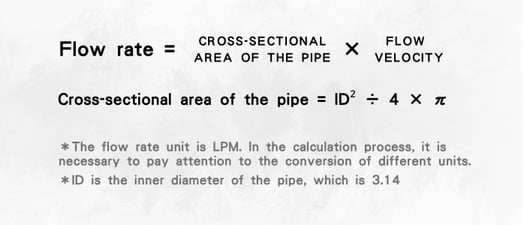
เมื่อทำการคำนวณ สิ่งสำคัญคือต้องแปลงหน่วยต่างๆ ให้สอดคล้องกัน ตัวอย่างง่ายๆ ในการใช้สูตรคำนวณอัตราการไหลมีดังนี้:
สมมติว่ามีท่อที่มีเส้นผ่านศูนย์กลาง 2 นิ้ว และความเร็วการไหล 1 เมตรต่อวินาที คำถามคือ อัตราการไหลคือเท่าใด?
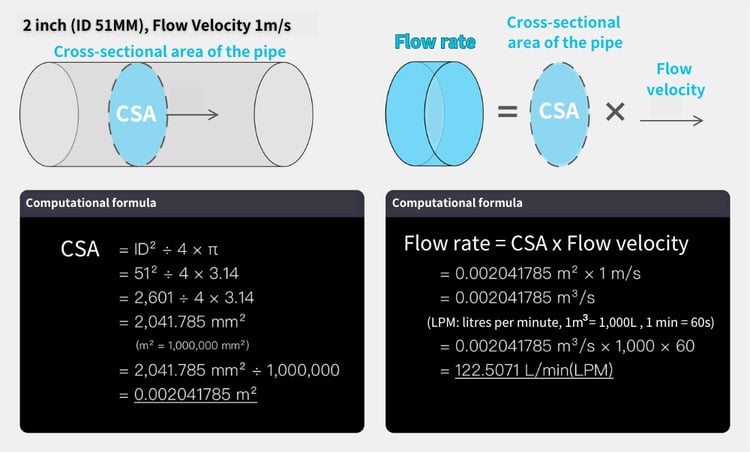
สำหรับท่อขนาด 2 นิ้วที่มีเส้นผ่านศูนย์กลางภายใน (ID) เท่ากับ 51 มม. พื้นที่หน้าตัดสามารถคำนวณได้โดยใช้สูตร (พื้นที่ = ID² ÷ 4 × π) ซึ่งผลลัพธ์จะได้พื้นที่เท่ากับ 0.002041785 ตารางเมตร
จากนั้น นำพื้นที่หน้าตัดคูณกับความเร็วการไหล ตามสูตรอัตราการไหล (อัตราการไหล = พื้นที่หน้าตัด × ความเร็วการไหล) จะได้อัตราการไหลเท่ากับ 122.5071 ลิตรต่อนาที (LPM)
[1]
2. เลือกเครื่องวัดการไหลที่เหมาะสมที่สุดโดยพิจารณาความสัมพันธ์ระหว่างอัตราการไหล ความเร็ว และเส้นผ่านศูนย์กลางของท่อ:
จากสูตรข้างต้น LORRIC ได้รวบรวมตารางที่ช่วยคำนวณหาค่าตัวแปรที่สาม เมื่อทราบค่าอัตราการไหลและเส้นผ่านศูนย์กลางของท่อ เพื่อกำหนดความเร็วที่เหมาะสม ข้อมูลนี้ช่วยในการเลือกเครื่องวัดการไหลที่เหมาะสมกับความต้องการของคุณ
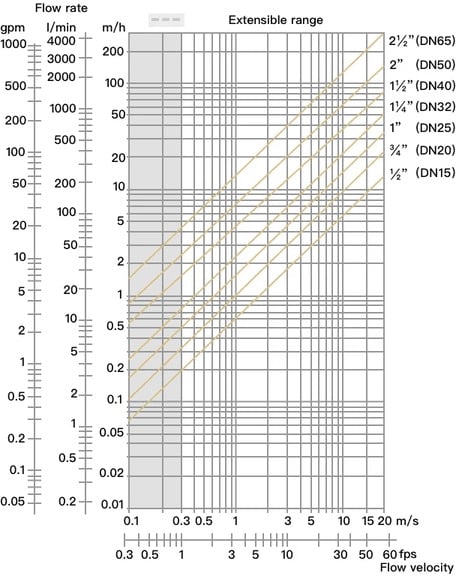
ตารางอัตราการไหล, ความเร็วการไหล และเส้นผ่านศูนย์กลางของท่อ (หน่วยอิมพีเรียล)
หน่วยอัตราการไหล: GPM (แกลลอนสหรัฐ/นาที), หน่วยความเร็วการไหล: ft/s, หน่วยเส้นผ่านศูนย์กลางท่อ: นิ้ว
ตัวอย่างการใช้งาน:
ตัวอย่างที่ 1: สำหรับท่อที่มีเส้นผ่านศูนย์กลาง 0.622 นิ้ว และความเร็วการไหล 0.3 ft/s อัตราการไหลคือ 0.28 GPM
ตัวอย่างที่ 2: สำหรับท่อที่มีเส้นผ่านศูนย์กลาง 1 นิ้ว และความเร็วการไหล 10 ft/s อัตราการไหลคือ 26.94 GPM
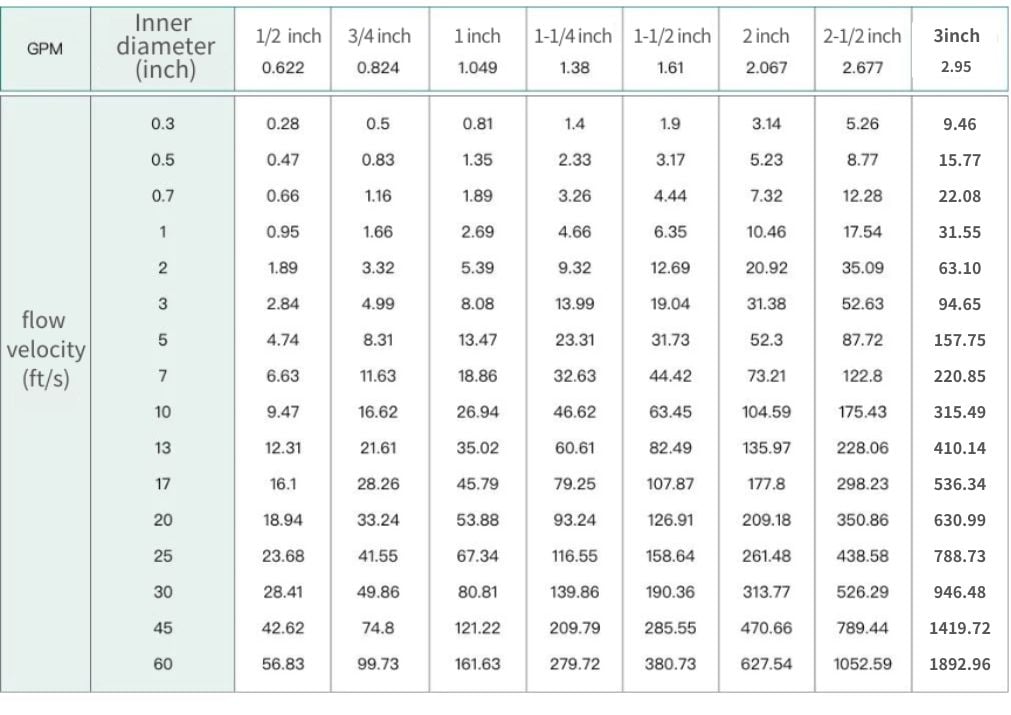
ตารางอัตราการไหล, ความเร็วการไหล และเส้นผ่านศูนย์กลางของท่อ (หน่วยเมตริก)
หน่วยอัตราการไหล: LPM (ลิตร/นาที), หน่วยความเร็วการไหล: m/s, หน่วยเส้นผ่านศูนย์กลางท่อ: มม.
ตัวอย่างการใช้งาน:
ตัวอย่างที่ 1: สำหรับท่อที่มีเส้นผ่านศูนย์กลาง 16 มม. (1/2 นิ้ว) และความเร็วการไหล 0.1 m/s อัตราการไหลคือ 1.2 LPM
ตัวอย่างที่ 2: สำหรับท่อที่มีเส้นผ่านศูนย์กลาง 25 มม. (1 นิ้ว) และความเร็วการไหล 1 m/s อัตราการไหลคือ 29.5 LPM
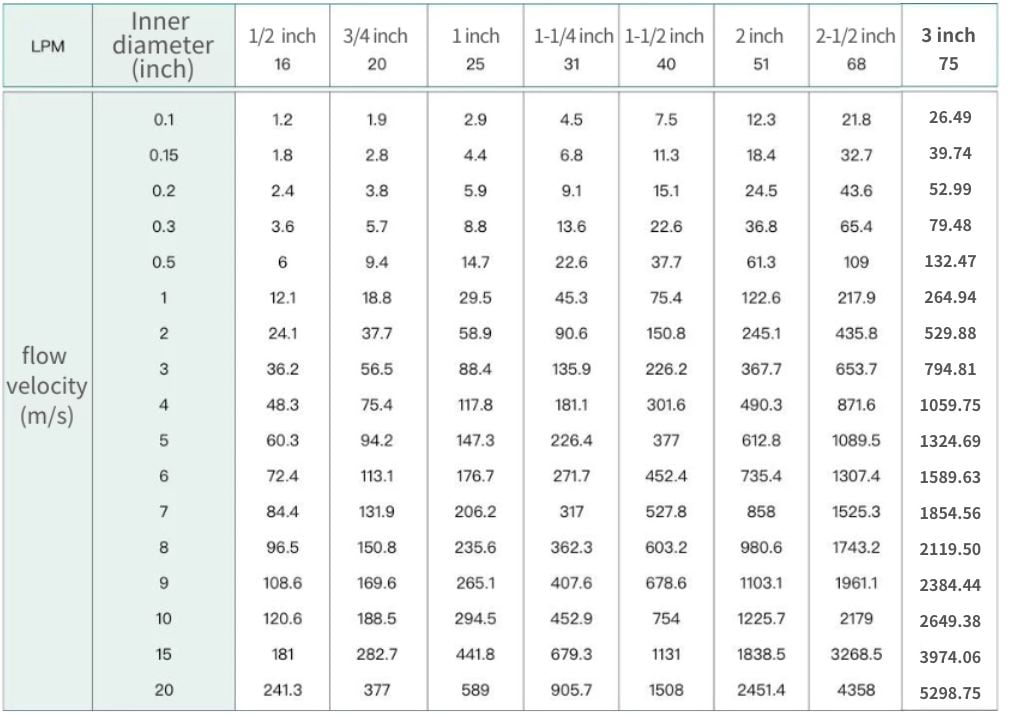
ช่วงความเร็วการไหลที่เหมาะสมสำหรับเครื่องวัดการไหลของ LORRIC
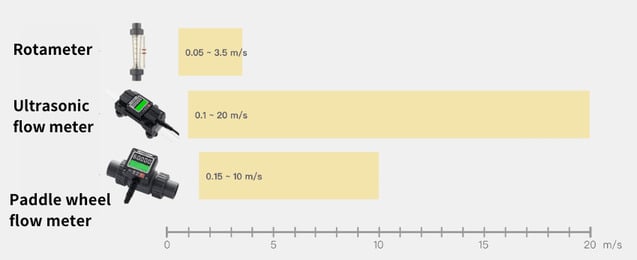
ช่วงความเร็วการไหลที่เหมาะสมสำหรับเครื่องวัดการไหลของ LORRIC ตามประเภทมีดังนี้:
• เครื่องวัดการไหลแบบ Variable Area (Float Type): 0.05 ~ 3.5 เมตรต่อวินาที
• เครื่องวัดการไหลแบบ Ultrasonic: 0.1 ~ 10 เมตรต่อวินาที
• เครื่องวัดการไหลแบบ AxleSense Paddle Wheel: 0.15 ~ 10 เมตรต่อวินาที
ที่สำคัญ เครื่องวัดการไหลแบบ AxleSense Paddle Wheel มีเทคโนโลยีการตรวจจับแกนหมุนที่จดสิทธิบัตร ซึ่งมอบช่วงการวัดที่กว้างกว่าเครื่องวัดที่คล้ายกันจากแบรนด์อื่นถึงสองเท่า
3. ทำความเข้าใจความเร็วการไหลและอัตราการไหล
1 ) ความเร็วการไหลคืออะไร?
ความเร็วการไหลคือความเร็วที่ของไหลเคลื่อนที่ โดยวัดจากระยะทางที่ของไหลเดินทางในหนึ่งหน่วยเวลา
[2]
2 ) อัตราการไหลคืออะไร?
อัตราการไหลหมายถึงปริมาณของไหล (ของเหลวหรือก๊าซ) หรือประจุที่ไหลผ่านพื้นที่ตัดขวางเฉพาะในหนึ่งหน่วยเวลา (หน่วยฐาน SI ที่เกี่ยวข้องคือวินาที) ปริมาณของไหลสามารถวัดได้ในรูปของปริมาตรหรือมวล ในขณะที่ปริมาณประจุวัดในหน่วยคูลอมบ์
LPM ที่ได้ยินบ่อยย่อมาจากลิตรต่อนาที (liter/minute [L/min]) ซึ่งหมายถึงปริมาตรของของเหลวที่ไหลต่อหนึ่งนาที โดยมักใช้วัดอัตราการไหลของของเหลว เช่น ในอุปกรณ์บำบัดน้ำและอัตราการจ่ายของเหลวในอุปกรณ์ทางการแพทย์
สำหรับการแปลงหน่วยอัตราการไหลอย่างรวดเร็ว โปรดเยี่ยมชม
ตัวแปลงหน่วยอัตราการไหลออนไลน์
3 ) คู่มือการเลือกเครื่องวัดการไหล
- หลักการอนุรักษ์การไหล: อัตราการไหลจะคงที่ตลอดท่อที่ไม่มีการรั่วไหลหรือแตกแขนง ดังนั้นควรติดตั้งเครื่องวัดในตำแหน่งที่มั่นคงเพื่อให้การวัดมีความแม่นยำและสม่ำเสมอ
- ความสัมพันธ์ระหว่างความเร็วการไหลและเส้นผ่านศูนย์กลางของท่อ: ความเร็วการไหลมีความสัมพันธ์ผกผันกับเส้นผ่านศูนย์กลางของท่อเมื่ออัตราการไหลคงที่ ดังนั้นควรหลีกเลี่ยงการเชื่อมต่อท่อขนาดใหญ่กับเครื่องวัดขนาดเล็ก เพราะอาจทำให้สูญเสียพลังงานและเกินขอบเขตการวัดของเครื่องวัด
- ข้อแตกต่างในเส้นผ่านศูนย์กลางภายในของท่อ: ท่อประเภทเดียวกันแต่เป็นมาตรฐานที่ต่างกัน อาจมีเส้นผ่านศูนย์กลางภายในที่แตกต่างกัน ซึ่งส่งผลกระทบต่อการคำนวณอัตราการไหลอย่างมาก
- การแปลงหน่วยในการคำนวณ: ให้ความสำคัญกับการแปลงหน่วย เช่น มิลลิลิตรเป็นลิตร หรือมิลลิเมตรเป็นเมตร เพื่อให้ผลลัพธ์มีความถูกต้องมากที่สุด